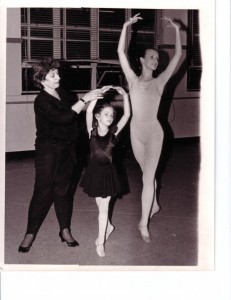 I am a teacher who is over 40, and I have noticed a few things that I would like to pass along to teachers who are no longer dancing full-time. Please feel free to share your own if any come to mind that aren’t on this list:
I am a teacher who is over 40, and I have noticed a few things that I would like to pass along to teachers who are no longer dancing full-time. Please feel free to share your own if any come to mind that aren’t on this list:
+ Be sure to warm up your feet and ankles prior to teaching a class. Taking a few minutes to stretch out your Achilles tendon and calf muscles can make a world of difference. I’ve noticed that my ligaments and tendons need a little blood flow to work properly now. Demi plies and slow ankle circles make a good warm-up.
+ Choose shoes carefully. I found that once I stopped dancing full-time it was less comfortable to wear regular technique slippers. I now use “dance sneakers,” but have seen teachers wear everything from character shoes to jazz shoes for teaching class. The important things are comfort and the ability to show the steps clearly to students.
+ Utilize students for demonstration. I’m no longer up to doing a grand jete–much less doing one without having done a barre first. When you can, use a student to demonstrate steps that can possibly cause you injury. It makes the student feel good and saves your body the impact.
+ Schedule yourself sensibly. You may want to spread classes out over a few days rather than doing four of them back-to-back. Your body will tell you what it can and cannot handle, so be sure to pay attention to the signs of overdoing it. If you feel stiff, bruised or exceptionally tired, you may be taking on too much at once.
It can be very difficult to adjust your teaching style to adapt to changes in your body as you get older. As dancers we don’t like limitations–we have been taught to push our bodies as hard as we can. Even so, making some minor adjustments can mean that you are able to teach more effectively as well as feel better physically, so it really is worth it in the long run.
Any tips to share?






Even young teachers stand to benefit from these tips, because teaching schedules are often tight enough that a teacher doesn’t have time to think of his/her own needs! The more careful you are as a young teacher, the longer it will take to become an older teacher!
I would add:
* Don’t always do the warm-up with your class. When you’re warming up with your class, you’re probably concentrating on demonstrating rather than thinking of what your own body needs. Once you’ve set up the warm-up, talk them through or use student leaders.
*NEVER demonstrate the wrong way of doing a move.
*Develop your ability to verbally articulate what they should be aiming for.
*Be sure you do movement on BOTH sides of your body equally, without favoring one side over the other (the emphasis on demonstration sometimes makes one oblivious to one’s own one-sidedness).
Thanks for opening this subject!
You are absolutely correct–thank you for adding your expertise Meg! You have given some excellent advice here.